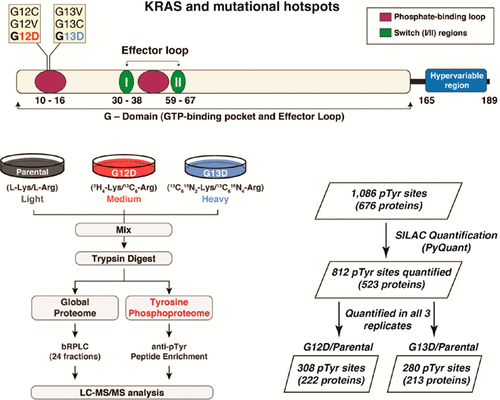当前位置:
X-MOL 学术
›
J. Proteome Res.
›
论文详情
Our official English website, www.x-mol.net, welcomes your
feedback! (Note: you will need to create a separate account there.)
Mutation-Specific and Common Phosphotyrosine Signatures of KRAS G12D and G13D Alleles
Journal of Proteome Research ( IF 3.8 ) Pub Date : 2020-09-28 , DOI: 10.1021/acs.jproteome.0c00587 Raiha Tahir 1, 2 , Santosh Renuse 3 , Savita Udainiya 4, 5, 6 , Anil K. Madugundu 3, 4, 5 , Jevon A. Cutler 3, 7 , Raja Sekhar Nirujogi 3 , Chan Hyun Na 8 , Yaoyu Xu 2, 3 , Xinyan Wu 2, 3 , Akhilesh Pandey 2, 3, 5, 6
Journal of Proteome Research ( IF 3.8 ) Pub Date : 2020-09-28 , DOI: 10.1021/acs.jproteome.0c00587 Raiha Tahir 1, 2 , Santosh Renuse 3 , Savita Udainiya 4, 5, 6 , Anil K. Madugundu 3, 4, 5 , Jevon A. Cutler 3, 7 , Raja Sekhar Nirujogi 3 , Chan Hyun Na 8 , Yaoyu Xu 2, 3 , Xinyan Wu 2, 3 , Akhilesh Pandey 2, 3, 5, 6
Affiliation

|
KRAS is one of the most frequently mutated genes across all cancer subtypes. Two of the most frequent oncogenic KRAS mutations observed in patients result in glycine to aspartic acid substitution at either codon 12 (G12D) or 13 (G13D). Although the biochemical differences between these two predominant mutations are not fully understood, distinct clinical features of the resulting tumors suggest involvement of disparate signaling mechanisms. When we compared the global phosphotyrosine proteomic profiles of isogenic colorectal cancer cell lines bearing either G12D or G13D KRAS mutation, we observed both shared as well as unique signaling events induced by the two KRAS mutations. Remarkably, while the G12D mutation led to an increase in membrane proximal and adherens junction signaling, the G13D mutation led to activation of signaling molecules such as nonreceptor tyrosine kinases, MAPK kinases, and regulators of metabolic processes. The importance of one of the cell surface molecules, MPZL1, which was found to be hyperphosphorylated in G12D cells, was confirmed by cellular assays as its knockdown led to a decrease in proliferation of G12D but not G13D expressing cells. Overall, our study reveals important signaling differences across two common KRAS mutations and highlights the utility of our approach to systematically dissect subtle differences between related oncogenic mutants and potentially lead to individualized treatments.
中文翻译:

KRAS G12D和G13D等位基因的突变特异性和常见的磷酸酪氨酸特征
KRAS是所有癌症亚型中最常见的突变基因之一。患者中观察到的两个最常见的致癌性KRAS突变导致第12个密码子(G12D)或第13个密码子(G13D)处的甘氨酸替换为天冬氨酸。尽管尚不完全了解这两个主要突变之间的生化差异,但所得肿瘤的独特临床特征表明它们涉及不同的信号传导机制。当我们比较带有G12D或G13D KRAS突变的等基因结直肠癌细胞系的全球磷酸酪氨酸蛋白质组学特征时,我们观察到了由两个KRAS诱导的共同以及独特的信号事件突变。值得注意的是,虽然G12D突变导致膜近端和粘附连接信号的增加,但G13D突变导致诸如非受体酪氨酸激酶,MAPK激酶和代谢过程调节剂的信号分子活化。细胞表面分子之一MPZL1在G12D细胞中被过度磷酸化的重要性已通过细胞分析得到了证实,因为其敲低导致表达G12D的细胞减少,但不表达G13D的细胞。总体而言,我们的研究揭示了两个常见KRAS突变之间重要的信号差异,并强调了我们的方法可用于系统地剖析相关致癌突变体之间的细微差异,并有可能导致个体化治疗。
更新日期:2020-09-28
中文翻译:

KRAS G12D和G13D等位基因的突变特异性和常见的磷酸酪氨酸特征
KRAS是所有癌症亚型中最常见的突变基因之一。患者中观察到的两个最常见的致癌性KRAS突变导致第12个密码子(G12D)或第13个密码子(G13D)处的甘氨酸替换为天冬氨酸。尽管尚不完全了解这两个主要突变之间的生化差异,但所得肿瘤的独特临床特征表明它们涉及不同的信号传导机制。当我们比较带有G12D或G13D KRAS突变的等基因结直肠癌细胞系的全球磷酸酪氨酸蛋白质组学特征时,我们观察到了由两个KRAS诱导的共同以及独特的信号事件突变。值得注意的是,虽然G12D突变导致膜近端和粘附连接信号的增加,但G13D突变导致诸如非受体酪氨酸激酶,MAPK激酶和代谢过程调节剂的信号分子活化。细胞表面分子之一MPZL1在G12D细胞中被过度磷酸化的重要性已通过细胞分析得到了证实,因为其敲低导致表达G12D的细胞减少,但不表达G13D的细胞。总体而言,我们的研究揭示了两个常见KRAS突变之间重要的信号差异,并强调了我们的方法可用于系统地剖析相关致癌突变体之间的细微差异,并有可能导致个体化治疗。





















































 京公网安备 11010802027423号
京公网安备 11010802027423号